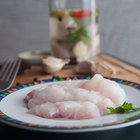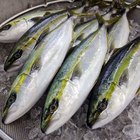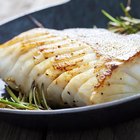
Many well-stocked markets carry sushi- or sashimi-grade salmon. The difference between sushi grade and ungraded fish is minimal, and sushi grade fish is labeled specifically so that you know it's parasite-free and safe to eat raw. Although it is meant to be eaten raw, it can be cooked just as you would cook a regular salmon dish if you choose to do so. Conversely, eating fish raw that is not labeled sushi grade is not advised as it may contain harmful parasites.
Definitions
There are no FDA guidelines specifically for labeling sushi- or sashimi-grade fish. However, there are rules for marketing raw fish as ready-to-eat and making sure they are parasite-free. Independent agents use the labels when measures have been taken to make sure that the fish is free of parasites. This doesn't affect the way that it will turn out if you cook it, so if sushi grade is what you have on hand and you want something cooked instead, go for it.
Ensuring Safety
To make sure that your fish is free of parasites, it is required to be frozen to a temperature of -4 degrees Fahrenheit or below for a minimum of seven days. This means that sushi-grade fish may actually not be fresh unless it's specifically labeled as such. Exceptions include shellfish, tuna and certain farm-raised fish, including farm-raised salmon. These fish are raised in a way to prevent infestation by parasites.
Searing Salmon
Sushi-grade salmon is generally pricier because of the extra steps that go into processing it. Raw fish has a very tender melt-in-your-mouth texture that you paid extra for, and because you know it's parasite-free, you should take advantage of it in some way. If sushi-grade salmon is what you have on hand and you are in the mood for something cooked, sear it instead of fully cooking it. Briefly seared fish is one way to ease unfamiliar diners into the raw fish realm.
Raw Preparation
Raw salmon's mild flavor and light texture make it perfect to prepare in a variety of cultural cuisines. For a quick and easy dish, cube and toss it with sesame oil, soy sauce, and a pinch of ginger. Dusted with a sprinkling of sesame seeds and a drizzle of maple syrup, this dish is sure to impress. Salmon ceviche is another good option -- simply toss cubes with lemon or lime juice, diced onions, garlic, tomatoes and cilantro. Sprinkle with salt and pepper to taste, and let it rest in the fridge overnight. The lemon will cure the fish, turning it opaque and giving it a cooked appearance.
Related Articles

Is Grocery Store Fish Safe for Sushi?

How to Grill a Cod Fish

How to Bake Mullet

Can You Eat Sockeye Salmon Raw?
How to Cook Salmon to Moist & Tender ...

How Long Does It Take for Salmon to ...

How Long Does Tilapia Last Refrigerated?

How to Cook Frozen, Boneless & Skinless ...

How to Pickle Fish

How to Pan-Sear Swordfish

How to Cook Eelpout

How Long Do You Cook Haddock Fillets in ...

How to Cook Swai White Fish on the Grill

Cooking Frozen Swai Fillets

How to Cook Ono Fish

The Best Way to Smoke Yellowtail

How to Cook Belt Fish

How Do I Pan Fry Fresh Fish With a ...

How to Brine Trout to Smoke

How to Cook Flathead
References
Writer Bio
Kimberly Blough is a food junkie residing in San Diego who began writing professionally in 2013. She obtained her Bachelor of Arts in geography from San Diego State University in 2003 and has taught culinary classes in various capacities since 2005. She teaches cheesemaking workshops and lives on a small hobby farm where she turns the food they grow into delectable dishes.
Photo Credits
Creatas/Creatas/Getty Images